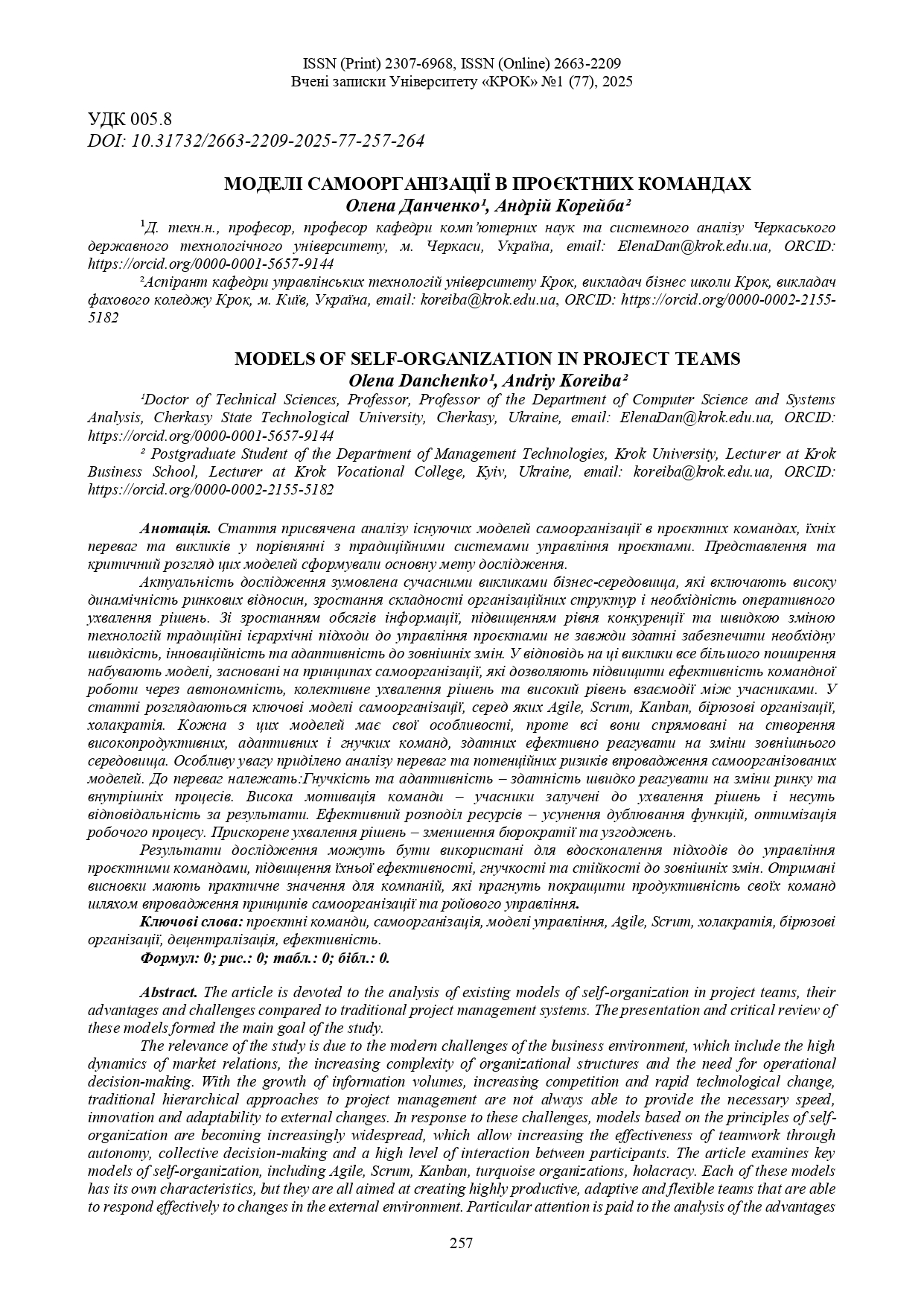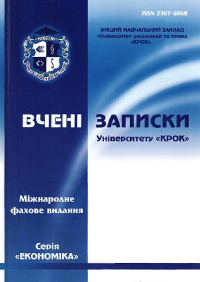MODELS OF SELF-ORGANIZATION IN PROJECT TEAMS
DOI:
https://doi.org/10.31732/2663-2209-2025-77-257-264Keywords:
project teams, self-organization, management models, Agile, Scrum, holacracy, turquoise organizations, decentralization, efficiencyAbstract
The article is devoted to the analysis of existing models of self-organization in project teams, their advantages and challenges compared to traditional project management systems. The presentation and critical review of these models formed the main goal of the study.
The relevance of the study is due to the modern challenges of the business environment, which include the high dynamics of market relations, the increasing complexity of organizational structures and the need for operational decision-making. With the growth of information volumes, increasing competition and rapid technological change, traditional hierarchical approaches to project management are not always able to provide the necessary speed, innovation and adaptability to external changes. In response to these challenges, models based on the principles of self-organization are becoming increasingly widespread, which allow increasing the effectiveness of teamwork through autonomy, collective decision-making and a high level of interaction between participants. The article examines key models of self-organization, including Agile, Scrum, Kanban, turquoise organizations, holacracy. Each of these models has its own characteristics, but they are all aimed at creating highly productive, adaptive and flexible teams that are able to respond effectively to changes in the external environment. Particular attention is paid to the analysis of the advantages and potential risks of implementing self-organized models. The advantages include: Flexibility and adaptability - the ability to quickly respond to changes in the market and internal processes. High team motivation - participants are involved in decision-making and are responsible for the results. Effective allocation of resources - eliminating duplication of functions, optimizing the workflow. Accelerated decision-making - reducing bureaucracy and coordination.
The results of the study can be used to improve approaches to managing project teams, increasing their efficiency, flexibility and resilience to external changes. The conclusions obtained have practical significance for companies that seek to improve the productivity of their teams by implementing the principles of self-organization and swarm management.
Downloads
References
Бушуєва Н., Бушуєв Д., Бушуєва В. (2019). AGILE лідерство управління проєктами інновацій. Сучасний стан наукових досліджень та технологій в промисловості. № 4(10). С. 77–84.
Данченко О., Корейба А. (2024). Аналіз впливу біологічних факторів на проєктну команду. Управління розвитком складних систем. № 59. С. 34–44.
Данченко О. Б., Кузьмінська Ю. М. (2012). Креативний потенціал команди як фактор успіху проєкту. Управління проєктами та розвиток виробництва: зб. наук. пр. СНУ. Луганськ: вид-во СНУ ім. В. Даля, № 3(43). С. 70-74.
Рибалко І. В., Алькема В. Г. (2019). Сучасні підходи до управління командою проєктів у творчій сфері. Професійний менеджмент у сучасних умовах розвитку ринку: матеріали доповідей VIII наук.-практ. конф. з міжнародною участю, м. Харків, 1 листопада 2019 р. Харків: Монограф, С. 230-232.
Сазонова Т., Кемова Я., Яковлєва К.(2022). Методи управління командою: аспект самоорганізації. Економічний простір. № 181. С. 138-142. DOI: https://doi.org/10.32782/2224-6282/181-24
Сазерленд Д. SCRUM. (2022)Революційний спосіб управління проєктами. КСД, 280 с.
Швець В. Я. (2024). Управління ефективністю роботи проєктних команд в організаціях [Електронний ресурс]. – Режим доступу: https://ev.nmu.org.ua/docs/2024/3/EV20243_120-130.pdf
Аппело Юргент. (2019). Менеджмент 3.0. Agile-менеджмент. Лідерство та управління командами. Харків: Фабула.
Вервейс К., Руссо Д. (2022). Теорія ефективності команди Scrum [Електронний ресурс]. – Режим доступу: https://arxiv.org/abs/2105.12439
Laloux F. (2019). Reinventing Organizations: An Illustrated Invitation to Join the Conversation on Next-Stage Organizations. Nelson Parker.
Robertson B. Holacracy(2015): The New Management System for a Rapidly Changing World. Henry Holt and Company, 240 p.
Sutherland J.(2015) Scrum: The Art of Doing Twice the Work in Half the Time. 280 p.
References:
Bushueva N., Bushuyev D., Bushueva V. (2019). AGILE leadership in innovation project management. Current state of scientific research and technologies in industry. No. 4(10). P. 77–84.
Danchenko O., Koreyba A. (2024). Analysis of the influence of biological factors on the project team. Management of complex systems development. No. 59. P. 34–44.
Danchenko O. B., Kuzminska Yu. M. (2012). Creative potential of the team as a factor in project success. Project management and production development: collection of scientific works of the SNU. Lugansk: Publishing house of the SNU named after V. Dal, No. 3(43). P. 70-74.
Rybalko I. V., Alkema V. G. (2019). Modern approaches to project team management in the creative sphere. Professional management in modern market development conditions: materials of the reports of the VIII scientific-practical conference with international participation, Kharkiv, November 1, 2019. Kharkiv: Monograph, pp. 230-232.
Sazonova T., Kemova Ya., Yakovleva K. (2022). Team management methods: the aspect of self-organization. Economic Space. No. 181. pp. 138-142. DOI: https://doi.org/10.32782/2224-6282/181-24
Sutherland D. SCRUM. (2022) Revolutionary method of project management. KSD, 280 p.
Shvets V. Ya. (2024). Managing the effectiveness of project teams in organizations [Electronic resource]. – Access mode: https://ev.nmu.org.ua/docs/2024/3/EV20243_120-130.pdf
Appelo Yurgent. (2019). Management 3.0. Agile management. Leadership and team management. Kharkiv: Fabula.
Verweijs K., Russo D. (2022). Scrum team effectiveness theory [Electronic resource]. – Access mode: https://arxiv.org/abs/2105.12439
Laloux F. (2019). Reinventing Organizations: An Illustrated Invitation to Join the Conversation on Next-Stage Organizations. Nelson Parker.
Robertson B. Holacracy(2015): The New Management System for a Rapidly Changing World. Henry Holt and Company, 240 p.
Sutherland J. (2015) Scrum: The Art of Doing Twice the Work in Half the Time. 280 p.

Downloads
Published
How to Cite
Issue
Section
License

This work is licensed under a Creative Commons Attribution-NonCommercial 4.0 International License.

